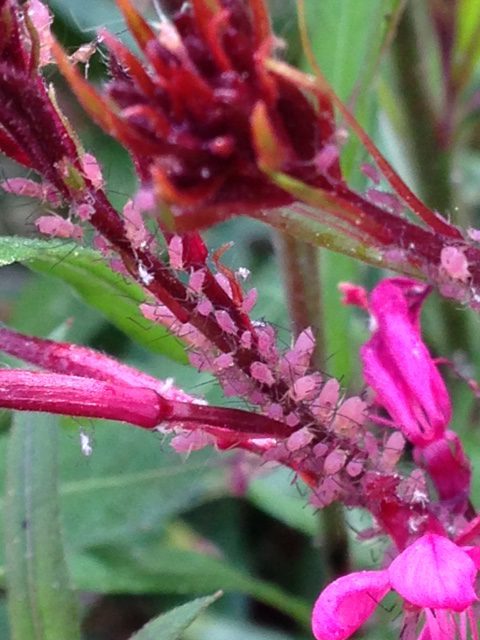
by Julie McConnell | May 5, 2016
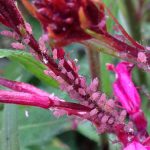
Aphids (Macrosiphum gaurae) feeding on gaura. Photo: Julie McConnell, UF/IFAS
Every day, if I get home before the sun goes down, I like to walk around my garden and see how things are growing. At this time of year there are always new surprises in the garden – plants leafing out after a winter break, new flower buds and blooms, and of course sometimes garden pests.
My daughter and I collected some flowers last weekend and after they sat on the table for a few minutes I noticed pink bugs crawling around on the gaura stems. On further inspection I realized the stem was covered in aphids which made me go out to look at the entire plant. I found a prolific population
of aphids on the gaura and also lady beetle larvae hunting and eating the aphids! Instead of mixing up a bottle of insecticidal soap I decided to let the lady beetles do their job and just monitor the situation.
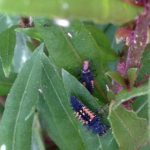
Multicolored Asian Lady Beetle Larvae feeding on aphids. Photo: Julie McConnell, UF/IFAS
Five days later I went to show my example of natural biological control to a visiting friend and we could not find a single aphid on my plant. This may not be the typical response, usually I see some level of both predator and prey but in this instance the lady beetle did a fantastic job of controlling the aphids.
So, did they eat every last one? Probably not, they likely ate many of them and the others left the plant because the predator pressure was too great. However, either scenario saved my plant from severe damage which was the overall goal.
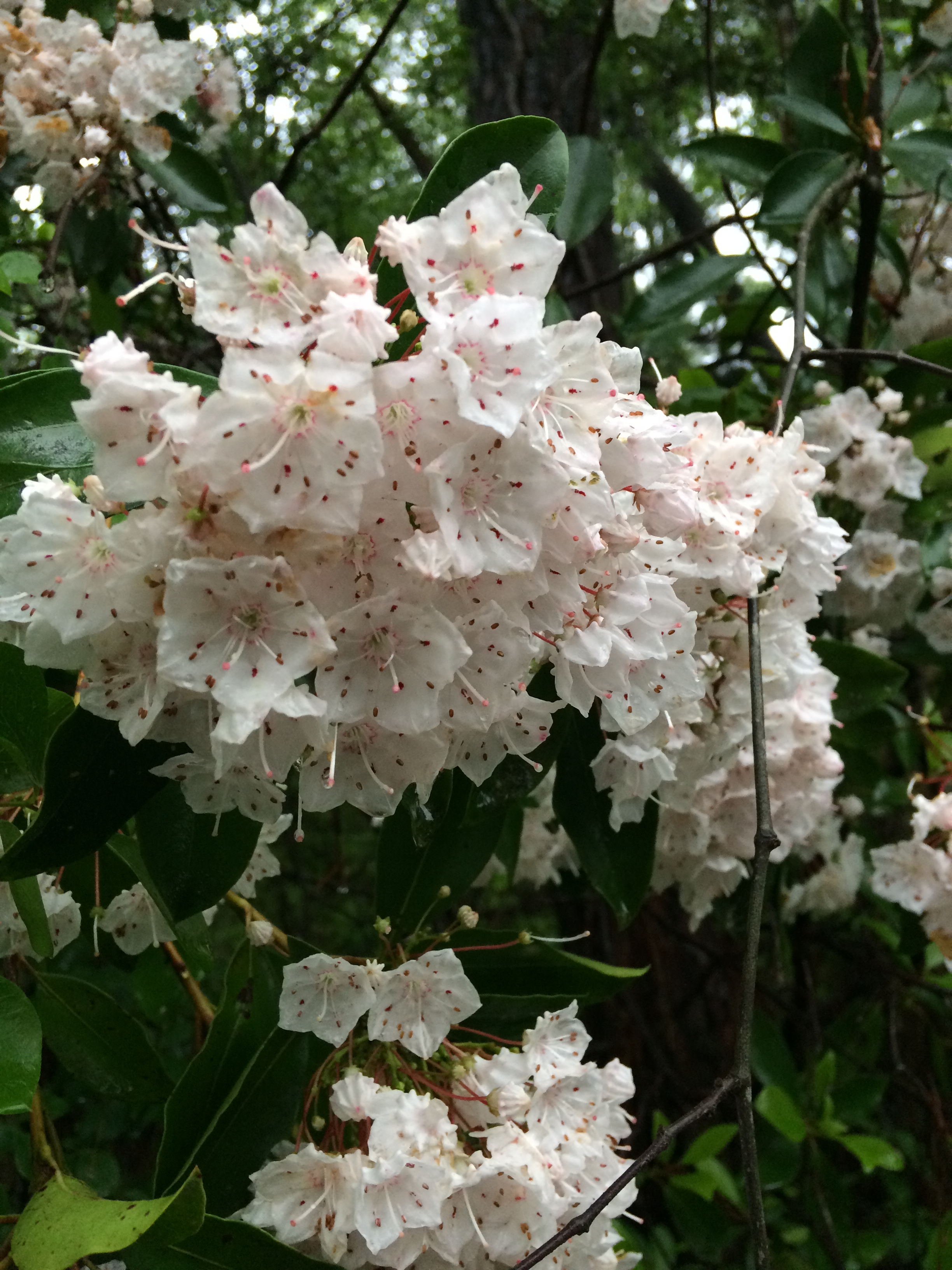
by Sheila Dunning | Apr 21, 2016
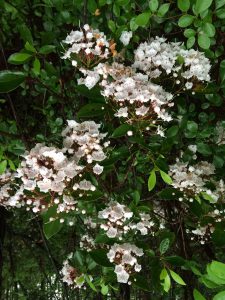
Mountain laurel. Photo credit: Sheila Dunning, UF/IFAS Extension.
If you are lucky enough to live on the southern Alabama edge of northwest Florida, you may want to see if you can find mountain laurel blooming now near the wooded creeks. Its native range stretches from southern Maine south to northern Florida, just dipping into our area. The plant is naturally found on rocky slopes and mountainous forest areas. Both are nearly impossible to find in Florida. However, it thrives in acidic soil, preferring a soil pH of 4.5 to 5.5 and oak-healthy forests. That is something we do have. The challenge is to find a cool slope near spring-fed water.
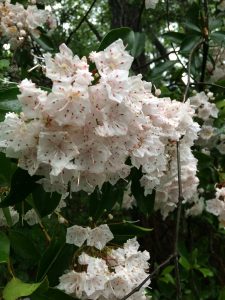
Mountain laurel blooms. Photo credit: Sheila Dunning, UF/IFAS Extension.
Mountain laurel (Kalmia latifolia) was first recorded in America in 1624, but it was named after Pehr Kalm, who had collected and submitted samples to Linnaeus in the 18th century. The wood of mountain laurel was popular for small household items. It is heavy and strong with a close, straight grain. However, as it grow larger it becomes brittle. Native Americans used the leaves as an analgesic. But, all parts of the plant are toxic to horses, goats, cattle, deer, monkeys and humans. In fact, food products made from it, including honey, can produce neurotoxic and gastrointestinal symptoms in people consuming more than a modest amount. Luckily, the honey is usually so bitter that most will avoid eating it.
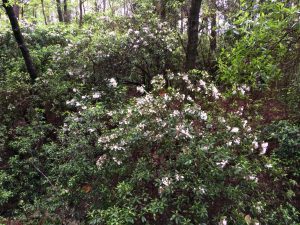
Mountain laurel in its native habitat. Photo credit: Sheila Dunning, UF/IFAS Extension.
One of the most unusual characteristics of mountain laurel is its unique method of dispersing pollen. As the flower grows, the filaments of its stamens are bent, creating tension. When an insect lands on the flower, the tension is released, catapulting the pollen forcefully onto the insect. Scientific experiments on the flower have demonstrated it ability to fling the pollen over 1/2 inch. I guess if you don’t taste that good, you have to find a way to force the bees to take pollen with them.
The mountain laurel in these pictures is from Poverty Creek, a small creek near our office in Crestview. This is their best bloom in 10 years. Maybe you can find some too.
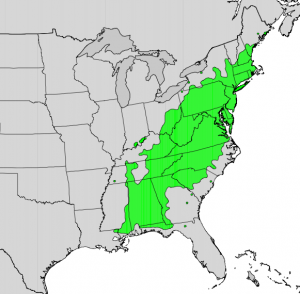
Native range of mountain laurel.

by Matt Lollar | Apr 14, 2016
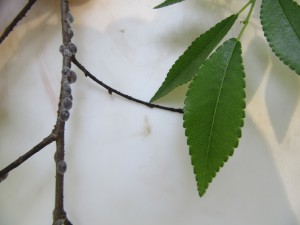
Scales on a Chinese Elm.
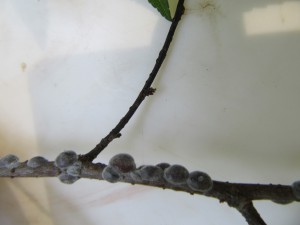
Scales on a Chinese Elm.
Last week as I was basking in the shade of the Chinese Elms (Ulmus parvifolia) in my yard, I noticed some strange lumps on the twigs. Upon further investigation, I realized the “lumps” were scales. Scale insects are serious pests of a number of ornamental plants. Here in Florida there are 13 different families of scales with the most common being armored scales, soft scales, and mealybugs. Scales have piercing-sucking mouthparts which they use to siphon fluids from the leaves, stems, and sometimes roots of many ornamental plants. Heavy infestations cause extensive leaf yellowing, premature leaf drop, branch dieback, and eventually plant death.
Scale Biology
The life cycle of a scale begins with eggs being laid beneath wax coverings or beneath the adult female. Eggs typically hatch in 1 to 3 weeks. The newly hatched nymphs, called crawlers, move around a plant until they find a spot to feed. Once a feeding site is located, their piercing sucking mouthparts are inserted into the plant and the crawlers begin to feed and grow. The males of many scale species develop wings as adults and fly to other plants to reproduce.
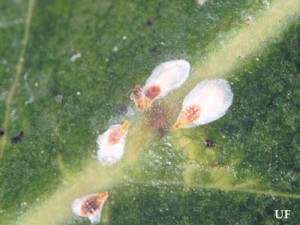
The magnolia white scale. Credits: University of Florida
Armored Scales
Armored scales get their armor by secreting a waxy covering over their bodies that is not attached. The scale lives under this covering and uses it as a protection to feed under. Armored scales can be almost any color or shape and range anywhere from 1/16 to 1/8 inch in diameter. For females, these shapes range from circular to oval to long and slender. The males typically have coverings that are more elongate and smaller than the females. As adults, the males are tiny, winged, gnat-like insects and are rarely seen.
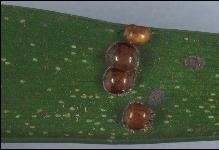
Hemispherical scale on coontie. Credits: Lyle Buss, University of Florida
Soft Scales
Similar to armored scales, soft scales secrete a waxy covering, but it is attached to their bodies. Soft scales can be a number of colors, shapes, and sizes and range anywhere from 1/8 to 1/2 inch in diameter. Their shapes vary from spherical to nearly flat.
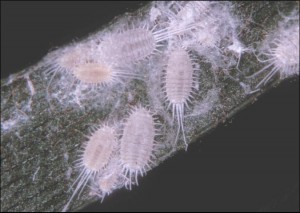
Mealybugs. Credits: James Castner, University of Florida
Mealybugs
Mealybugs are soft-bodied insects that possess a covering of flocculent, white, waxy filaments. They are about 1/8 inch in length and usually pinkish or yellowish in color. Mealybugs have piercing-sucking mouthparts which they use to siphon fluids from the leaves, stems, and sometimes roots of many ornamental plants. Mealybug damage produces discolored, wilted, and deformed leaves.
Scale and Mealybug Management
- Cultural Control – Plant inspection prior to purchase or installation is the first line of defense against a scale or mealybug population. Make sure to inspect the undersides of leaves and plant stems. Infested sections of plants can be pruned and plant material should be cleaned from the planting area and discarded. Also, you can increase air flow and decrease humidity by proper installation and pruning. Over-fertilizing can also increase pest populations.
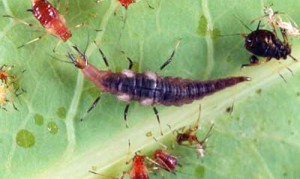
Larva of a brown lacewing. Credits: Lyle Buss, University of Florida.
- Biological Control – Predators, such as ladybugs and green lacewings, are usually present in large enough numbers to suppress scales and mealybugs to a desirable threshold. However, broad-spectrum insecticides and bad weather can reduce predator numbers. Look for signs of predation by inspecting dead scales for jagged holes in their waxy coatings. If predation signs are present, use more selective chemical controls and oils as opposed to broad-spectrum products.
- Chemical Control – Timing is everything when it comes to managing scale and mealybug insects. Crawler activity is more pronounced with the flush of new plant growth in the spring. Before application, prune infested plant parts off first to promote greater penetration of insecticides into the foliage. Contact products (acephate, bifenthrin, carbaryl, etc.) must be applied to inhibit the crawler stages of these insects and systemic products (acetamiprid, imidacloprid, thiamethoxam, etc.) can be used on the sessile growth stage. Plants should be sprayed thoroughly to the point of drip or “run off” from leaves, twigs, and stems. Repeated applications may still be necessary even if the timing is right, as crawler populations are often large and crawlers like to hide under old waxy scales. Systemic drenches are also a viable option. With good spray coverage, horticultural oils can kill scales at all stages of growth. Refer to the product label for phytotoxicity and temperature guidelines. Even after successful treatment, the outer coatings of the scales may remain on the plant material for weeks, which can be unsightly. The best way to determine if scales are dead is to squeeze them. They will be dry when squeezed if they are dead and they will ooze liquids if they are living (they were at least alive to the point of being squashed).
For insect identification and additional information on scale control, please see:
A Guide to Scale Insect Identification
UF/IFAS Featured Creatures
Your County Extension Office
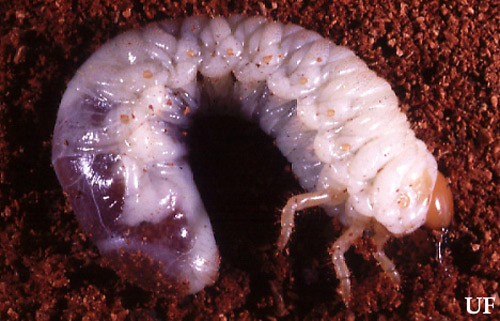
by Beth Bolles | Mar 2, 2016
A common question about insects when cold temperatures arrive is whether or not the cold will kill many pests. Although temperatures will occasionally drop below freezing in north Florida, it is normally not cold enough to significantly impact insect populations for the upcoming year.

Typical white grub of the genus Phyllophaga. Photograph by John L. Capinera, UF
Even when we do receive a significant amount of cold weather, insects have many methods to survive weather changes. Some insects survive by moving to micro-habitats that are more resistant to temperature fluctuations. Beetle larvae may move deep in the soil or into logs and trees for protection. The grubs can continue feeding on decomposing material throughout winter months. Beneficial insects such as dragonflies and damselflies stay protected in their nymph forms in the mud of ponds and lakes.
One of the most famous insect survival strategies is migration. We are all familiar with the late summer and fall flights of the monarch butterfly to warmer regions of Mexico and southern California. Those butterflies and moths that do not migrate have their own survival techniques. They will overwinter in protective pupal cases to emerge as adults in the spring. Moth cocoons are spun of silk and may be composed of multiple layers, making them a good protection for the transforming insect.
Insects are adapted for survival and can live through far colder winters than we experience. Even though our cold weather will not drastically change insect populations, periods of cold will at least slow down their activity enough for us to enjoy a break from many pest worries.
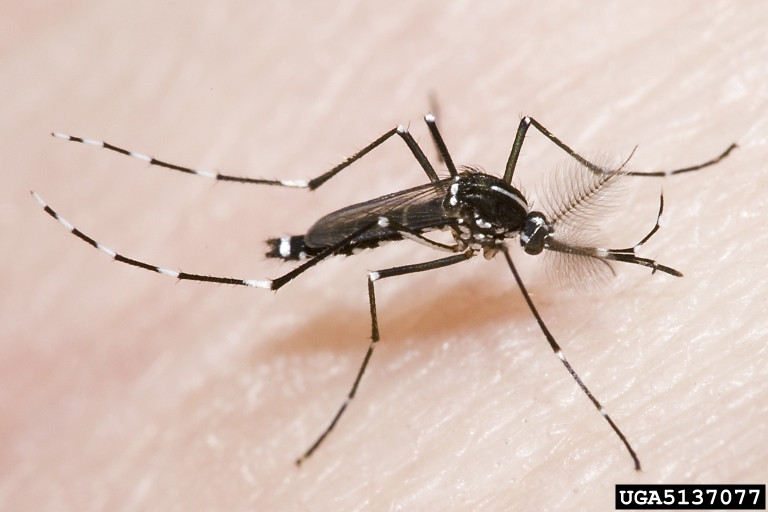
by Mary Salinas | Nov 9, 2015
Are you plagued with mosquitoes in your yard? Does it seem like you have a greater infestation than your neighbors? There may be some solutions to solve the problem other than using pesticides that negatively impact beneficial insects in your landscape.
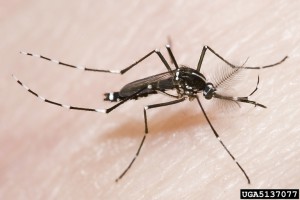
Asian tiger mosquito. Photo credit: Susan Ellis, Bugwood.org.
Mosquitoes are not only annoying, they can transmit serious diseases such as: eastern equine encephalitis, dengue fever, dog or cat heartworm, chikungunya, malaria, St. Louis encephalitis and west Nile virus.
Let’s first explore what kind of environment in your landscape and around your home is friendly to the proliferation of mosquitos. Adult mosquitoes lay their eggs on or very near water that is still or stagnant. That is because the larvae live in the water but have to come to the surface regularly to breeze. The small delicate larvae need the water surface to be still in order to surface and breathe. Water that is continually moving or flowing inhibits mosquito populations.
Look around your home and landscape for these possible sites of still water that can be excellent mosquito breeding grounds:
- bird baths
- potted plant saucers
- pet dishes
- old tires
- ponds
- roof gutters
- tarps over boats or recreational vehicles
- rain barrels (screen mesh over the opening will prevent females from laying their eggs)
- bromeliads (they hold water in their central cup or leaf axils)
- any other structure that will hold even a small amount of water (I even had them on a heating mat in a greenhouse that had very shallow puddles of water!)
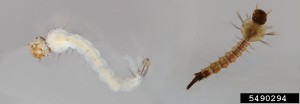
Mosquito larvae. Photo credit: Ari Farajollahi, Bugwood.org.
You may want to rid yourself of some of these sources of standing water or empty them every three to four days. What if you have bromeliads, a pond or some other standing water and you want to keep them and yet control mosquitoes? There is an environmentally responsible solution. Some bacteria, Bacillus thuringiensis ssp. israelensis or Bacillus sphaericus, only infects mosquitoes and other close relatives like gnats and blackflies and is harmless to all other organisms. Look for products on the market that contain this bacteria.
For more information:
UF/IFAS Mosquito Information Website
Biological Control of Mosquitoes



















